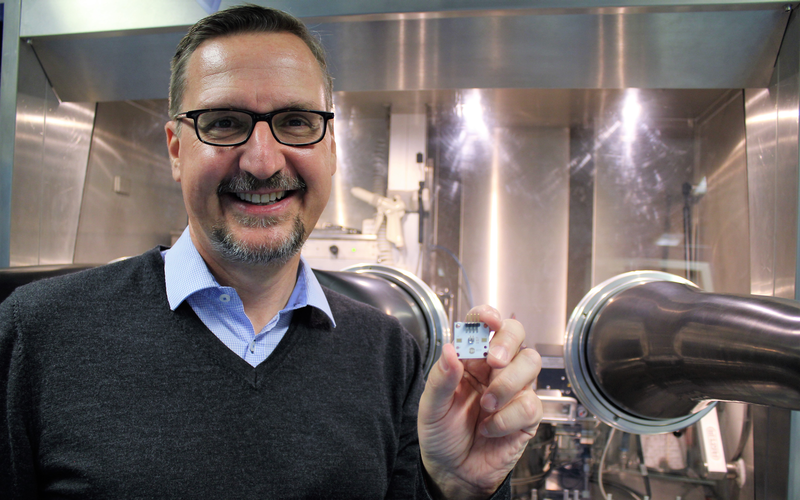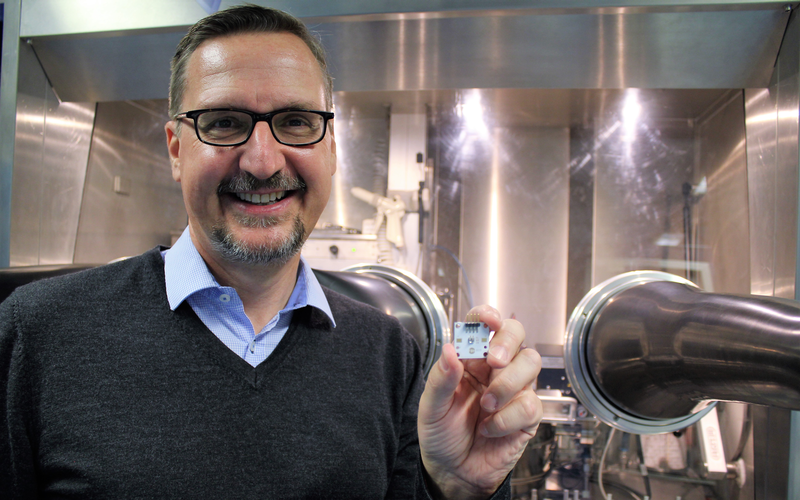Zapping Germs with LEDs
Michael Kneissl is no germaphobe, but he’s wary about the water he uses. He avoids, for example, washing his hands with the supplied water on a train or a plane, as that water can sit stagnant for long periods under warm conditions, offering germs a cozy environment to grow. Kneissl, a semiconductor physicist at the Technical University of Berlin, is working on a way to guarantee water safety that involves placing UV LEDs in the faucet to zap germs as they flow by.
UV light is a proven disinfectant, and small-scale UV-LED devices are commercially available for that purpose. However, the efficiency of UV LEDs is currently too low for many applications. Kneissl and his colleagues are developing new materials and designs for UV LEDs that they hope will make them as efficient as their visible counterparts. Physics spoke to Kneissl about his work and about the advantages that LEDs have over other disinfecting methods in the war against germs.
All interviews are edited for brevity and clarity.
When did you start working on UV LEDs?
In 2001. The United States government initiated a program to develop UV biosensors as a response to terrorist attacks involving letters filled with deadly anthrax spores. So I began working on UV LEDs for biosensing but also for other applications, such as curing, phototherapy, plant-growth lighting, and water treatment. In 2013, I helped establish the “Advanced UV for Life” consortium, which now has nearly fifty research partners that work together on UV LED development. One of our main projects at the moment is disinfection.
Why is UV light a good disinfectant?
UV photons can break molecular bonds, leading to damage of DNA and RNA. This damage can kill bacteria and can neutralize viruses such as SARS-CoV-2, the virus that causes COVID-19. And, unlike antibiotics and vaccines, germs appear unable to develop a resistance to UV light.
What options are there for producing UV light for disinfection?
The most common method is to use mercury lamps, which are widely used by public utilities for disinfecting water from large holding tanks. There is also increasing interest in using mercury lamps for air treatment and for disinfecting hospital rooms.
Mercury lamps are a high-power, relatively cheap UV light source. But there are several problems with the technology. First of all, mercury is a toxic substance that environmentalists would like to see phased out of use. The lamp bulbs are also fragile, and they can take several minutes to warm up and reach their maximum power level, meaning they don’t work well for intermittent disinfecting.
What makes the UV LED an attractive alternative?
LEDs contain no toxic heavy elements, and they reach maximum power almost instantly when turned on. LEDs are small and lightweight, making them practical on a camping trip to sterilize a bottle of water or in an elevator to purify the air entering through the ventilation system. LEDs are also durable, allowing them to be installed in places where a mercury lamp might get broken. For example, a German company is equipping ambulances with UV LEDs that disinfect the interior after a patient is dropped off at the hospital. Another advantage of LEDs is that their wavelength can be tuned. By altering the composition of the aluminum-gallium-nitride semiconductor used in the LEDs, researchers can create LEDs that emit anywhere between 210 and 365 nm. By contrast, mercury lamps primarily emit at a fixed wavelength of 254 nm.
Given these advantages, why are UV LEDs still quite rare?
Mostly because their efficiencies are low. The typical wall-plug efficiency—the light power out divided by the electricity power in—is around 6% for LEDs used in disinfection. Mercury lamps have efficiencies around 20–40%. However, our group and others are working on improving UV-LED efficiencies by developing materials that can better channel UV photons out of the device. It’s worth remembering that blue LEDs had low efficiencies in the 1990s, but they are now about 80% efficient. Several large LED manufacturers are entering the UV market, so that should speed up efficiency improvements—as well as bring prices down.
What are some of the disinfection devices that your group is developing?
We recently demonstrated a device that uses UV LEDs to disinfect a cell phone, since that is a place where a lot of germs collect. For this application, we tuned the LEDs to emit between 260 and 270 nm, which is the most effective wavelength range for killing bacteria and viruses.
We also have a collaboration with health professionals to develop an instrument that will shine UV light on a patient’s skin before surgery. In this case, we plan to use LEDs that emit at 230 nm, which is a wavelength that can kill germs but that doesn’t penetrate very far into the skin—thus protecting the patient’s cells. We have partners that are also looking at using UV LEDs to target SARS-CoV-2 in the nose or throat. If proven safe and effective, we could begin clinical trials on human beings in a year or so.
What about LEDs for faucets? Can germs really be killed as they flow by a light?
To kill bacteria, the required UV fluence is about 40 mJ/cm2. A rough estimate shows that 1 W of LED power could disinfect the water flowing out of a fully open faucet. Currently, a single LED has a power of 100 mW, so ten LEDs would be sufficient.
Some companies are already starting to offer such point-of-use disinfection. In the future, these systems could be installed in a rural village to sterilize well water. And assuming that efficiencies continue to improve, the LEDs could get all their energy from a small battery or solar panel.
Correction (9 September 2021): A previous version of the story incorrectly referred to laser fluence as intensity.
–Michael Schirber
Michael Schirber is a Corresponding Editor for Physics Magazine based in Lyon, France.





